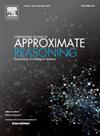FCPCA:基于共主成分分析的高维时间序列模糊聚类
IF 3
3区 计算机科学
Q2 COMPUTER SCIENCE, ARTIFICIAL INTELLIGENCE
引用次数: 0
摘要
聚类多变量时间序列数据是许多领域的关键任务,因为它可以在时间演变的数据中识别有意义的模式和组。传统的方法,如脆聚类,依赖于这样的假设,即聚类是充分分离的,几乎没有重叠。然而,现实世界的数据经常违背这一假设,显示重叠的分布或重叠的点云和模糊的集群之间的边界。模糊聚类提供了一种令人信服的替代方案,它允许多个集群中的部分成员关系,使其非常适合这些模糊的场景。尽管目前的模糊聚类方法有很多优点,但它主要集中在单变量时间序列上,对于多变量情况,即使是中等维数的数据集也会变得难以计算。当处理不同长度的时间序列时,这一挑战进一步加剧,在处理现代数据集的复杂性方面留下了明显的差距。本文提出了一种基于共同主成分分析的模糊聚类方法来解决上述缺点。该方法在保留关键时间特征的同时,通过降维有效地处理高维多变量时间序列。大量的数值结果表明,我们提出的聚类方法优于文献中现有的几种方法。一个有趣的应用程序涉及从模拟驾驶实验中记录的不同驾驶员的大脑信号,说明了这种方法的潜力。本文章由计算机程序翻译,如有差异,请以英文原文为准。
FCPCA: Fuzzy clustering of high-dimensional time series based on common principal component analysis
Clustering multivariate time series data is a crucial task in many domains, as it enables the identification of meaningful patterns and groups in time-evolving data. Traditional approaches, such as crisp clustering, rely on the assumption that clusters are sufficiently separated with little overlap. However, real-world data often defy this assumption, showing overlapping distributions or overlapping clouds of points and blurred boundaries between clusters. Fuzzy clustering offers a compelling alternative by allowing partial membership in multiple clusters, making it well-suited for these ambiguous scenarios. Despite its advantages, current fuzzy clustering methods primarily focus on univariate time series, and for multivariate cases, even datasets of moderate dimensionality become computationally prohibitive. This challenge is further exacerbated when dealing with time series of varying lengths, leaving a clear gap in addressing the complexities of modern datasets. This work introduces a novel fuzzy clustering approach based on common principal component analysis to address the aforementioned shortcomings. Our method has the advantage of efficiently handling high-dimensional multivariate time series by reducing dimensionality while preserving critical temporal features. Extensive numerical results show that our proposed clustering method outperforms several existing approaches in the literature. An interesting application involving brain signals from different drivers recorded from a simulated driving experiment illustrates the potential of the approach.
求助全文
通过发布文献求助,成功后即可免费获取论文全文。
去求助
来源期刊

International Journal of Approximate Reasoning
工程技术-计算机:人工智能
CiteScore
6.90
自引率
12.80%
发文量
170
审稿时长
67 days
期刊介绍:
The International Journal of Approximate Reasoning is intended to serve as a forum for the treatment of imprecision and uncertainty in Artificial and Computational Intelligence, covering both the foundations of uncertainty theories, and the design of intelligent systems for scientific and engineering applications. It publishes high-quality research papers describing theoretical developments or innovative applications, as well as review articles on topics of general interest.
Relevant topics include, but are not limited to, probabilistic reasoning and Bayesian networks, imprecise probabilities, random sets, belief functions (Dempster-Shafer theory), possibility theory, fuzzy sets, rough sets, decision theory, non-additive measures and integrals, qualitative reasoning about uncertainty, comparative probability orderings, game-theoretic probability, default reasoning, nonstandard logics, argumentation systems, inconsistency tolerant reasoning, elicitation techniques, philosophical foundations and psychological models of uncertain reasoning.
Domains of application for uncertain reasoning systems include risk analysis and assessment, information retrieval and database design, information fusion, machine learning, data and web mining, computer vision, image and signal processing, intelligent data analysis, statistics, multi-agent systems, etc.
 求助内容:
求助内容: 应助结果提醒方式:
应助结果提醒方式:


